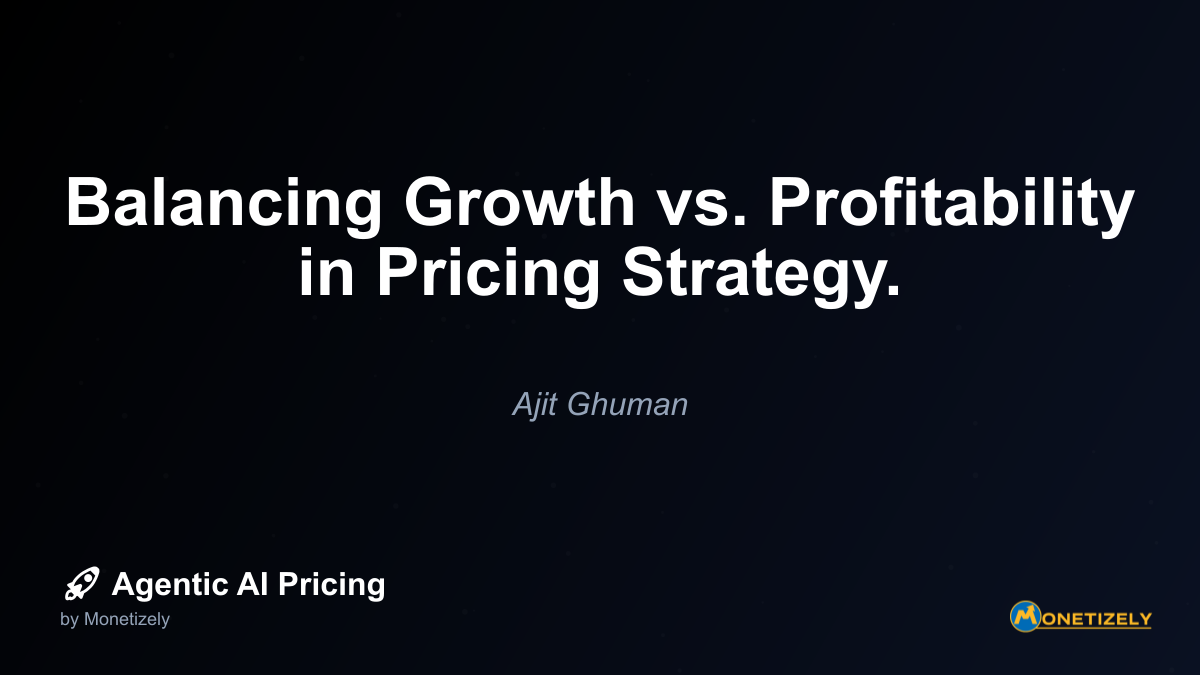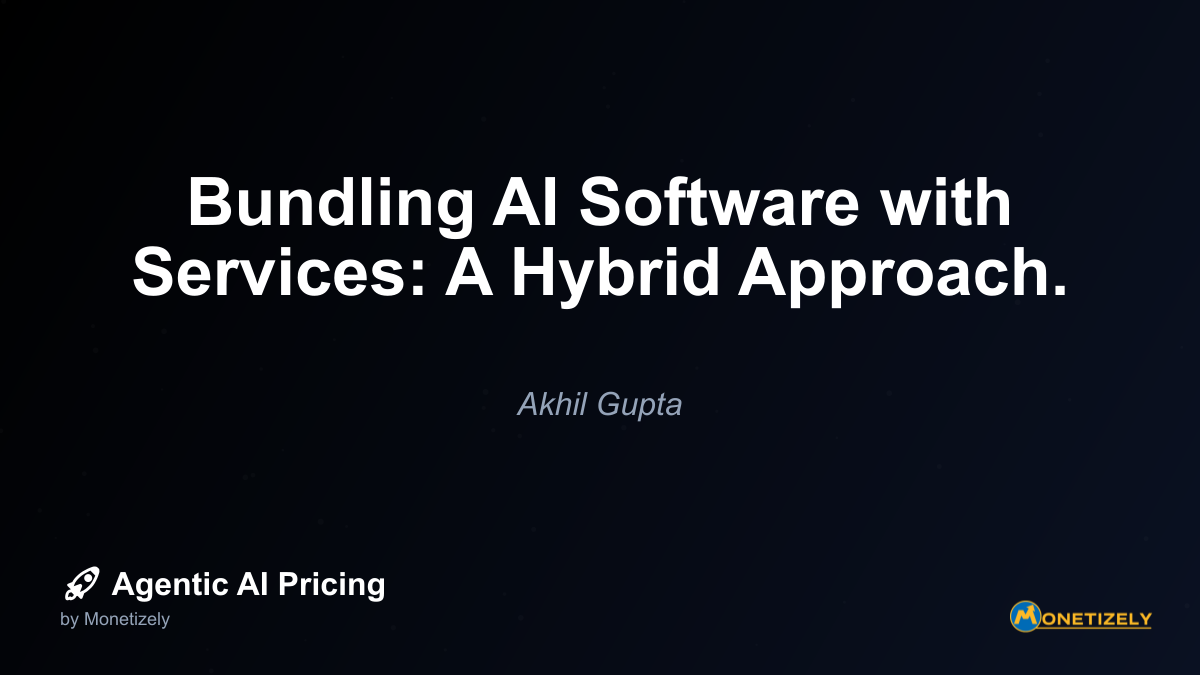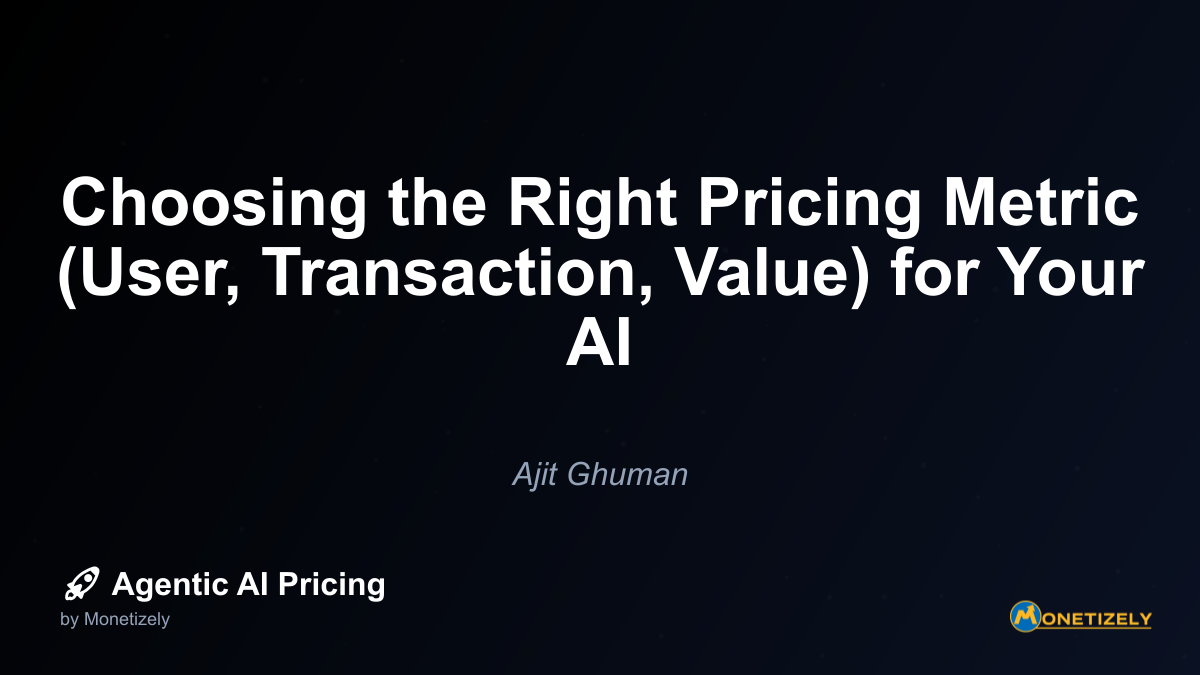· Ajit Ghuman · Strategy & Planning · 8 min read
Future-Proofing: Adapting Your AI Pricing to Market Changes.
AI and SaaS Pricing Masterclass
Learn the art of strategic pricing directly from industry experts. Our comprehensive course provides frameworks and methodologies for optimizing your pricing strategy in the evolving AI landscape. Earn a professional certification that can be imported directly to your LinkedIn profile.

Utilize Value-Based Pricing Components
Value-based pricing approaches inherently adapt to changing market conditions because they anchor to customer outcomes rather than costs or competitive benchmarks. Consider implementing:
- Success-based pricing tied to customer-defined outcomes
- ROI-sharing models that scale with customer value realization
- Performance tiers that adjust pricing based on quality metrics
- Value-discovery processes that regularly reassess customer benefits
As research on AI product pricing frameworks suggests, value-based components create natural adaptation mechanisms, as pricing automatically adjusts when customer value changes, without requiring explicit pricing revisions.
Design for Scalable Cost Management
Future-proof pricing requires a deep understanding of how your cost structures will evolve with scale. This includes:
- Modeling cost curves across different volume scenarios
- Identifying potential economies and diseconomies of scale
- Building pricing tiers that maintain margins as volumes change
- Understanding fixed versus variable cost components
- Planning for technology refresh cycles that might affect costs
By anticipating how costs will evolve, you can design pricing that remains viable across different growth trajectories and technology evolution paths.
Developing Market Intelligence Capabilities
Adaptive pricing requires robust market intelligence to identify when and how to evolve your approach. Organizations should invest in systematic intelligence gathering across several dimensions:
Competitive Pricing Intelligence
Develop structured approaches to monitoring competitor pricing, including:
- Regular competitive pricing audits
- Mystery shopping programs
- Customer and prospect debriefing protocols
- Channel partner intelligence gathering
- Industry analyst relationships
- Participation in relevant communities and forums
This intelligence should be systematically collected, analyzed, and integrated into pricing governance processes to identify emerging trends before they become market-wide shifts.
Customer Value Perception Monitoring
Understanding evolving customer value perception is crucial for maintaining pricing alignment. Consider implementing:
- Regular value realization assessments with customers
- Structured feedback mechanisms focused on pricing and value
- Win/loss analysis with specific pricing components
- Usage pattern analysis to identify changing value drivers
- Customer advisory boards with pricing discussion components
These mechanisms provide early warning when value perceptions are shifting, allowing proactive pricing adjustments before customer satisfaction or competitive position is compromised.
Technology and Cost Monitoring
To anticipate changes in underlying economics, establish systematic monitoring of:
- Computational resource pricing trends
- New efficiency technologies and approaches
- Infrastructure optimization opportunities
- Alternative technology stacks and approaches
- Industry benchmarks for similar workloads
This intelligence helps identify when cost structures are changing in ways that might enable pricing evolution—either to increase margins or to proactively adjust pricing before competitors force the issue.
Regulatory Horizon Scanning
Given the evolving regulatory landscape for AI, organizations should implement:
- Regular regulatory reviews with legal and compliance teams
- Participation in industry standards bodies
- Monitoring of legislative developments in key markets
- Assessment of regulatory impact on pricing models
- Scenario planning for potential regulatory changes
This scanning helps identify when regulatory changes might necessitate pricing adjustments, either due to new compliance costs or changes in deployment models.
Implementing Pricing Evolution with Minimal Friction
When market changes necessitate pricing evolution, the implementation approach is crucial for maintaining customer relationships and market position. Several strategies can minimize friction during pricing transitions:
Transparent Communication Strategies
When pricing changes become necessary, transparency builds trust and reduces resistance. Consider:
- Providing clear rationales linked to value delivery or market changes
- Communicating changes well in advance of implementation
- Offering detailed explanations of how changes affect different customer segments
- Providing tools to help customers understand impacts on their specific usage
- Creating dedicated support channels for pricing transition questions
Transparency transforms pricing changes from potential relationship challenges to opportunities for reinforcing value propositions and market leadership.
Grandfathering and Transition Programs
To minimize disruption, consider structured transition approaches:
- Grandfathering existing customers on current pricing for defined periods
- Creating phased transition plans for high-impact customers
- Offering alternative plans that might better align with specific usage patterns
- Providing incentives for early adoption of new pricing structures
- Creating migration tools and resources
These approaches balance the need for pricing evolution with customer relationship preservation, allowing strategic pricing changes without disrupting existing business.
Value Enhancement with Pricing Changes
Whenever possible, pair pricing changes with value enhancements:
- Introduce new capabilities alongside pricing adjustments
- Improve service levels or support offerings
- Enhance reporting or analytics capabilities
- Streamline onboarding or implementation processes
- Provide additional training or enablement resources
This approach transforms pricing changes from potential negatives to overall value improvements, reducing resistance and potentially increasing customer satisfaction despite price adjustments.
Creating a Culture of Pricing Adaptability
Beyond specific mechanisms and processes, future-proofing pricing requires organizational culture changes that embrace pricing as an evolving strategic capability:
Cross-Functional Pricing Ownership
Move beyond viewing pricing as solely a product management or finance function by:
- Creating cross-functional pricing committees with representation from product, sales, marketing, customer success, and finance
- Establishing shared metrics that align different functions around pricing success
- Developing joint accountability for pricing outcomes
- Building pricing consideration into product development processes
- Integrating pricing strategy into overall business planning
This shared ownership ensures that pricing evolution incorporates diverse perspectives and aligns with broader organizational strategies.
Data-Driven Pricing Decisions
Build capabilities for evidence-based pricing evolution:
- Invest in pricing analytics capabilities and tools
- Establish experimental approaches to test pricing changes
- Develop pricing dashboards that highlight key metrics and trends
- Create simulation capabilities to model pricing change impacts
- Build customer segmentation models that inform targeted pricing approaches
These capabilities transform pricing from intuition-based decisions to data-driven strategies, increasing confidence in pricing changes and improving outcome predictability.
Continuous Learning Mindset
Foster organizational approaches that treat pricing as an ongoing learning process:
- Document pricing decisions and their rationales
- Conduct post-implementation reviews of pricing changes
- Share pricing insights across product teams and business units
- Participate in industry pricing forums and communities
- Invest in pricing skill development across the organization
This learning mindset transforms pricing failures from setbacks to valuable insights, accelerating organizational pricing capabilities over time.
Case Study: Adapting AI Pricing in Response to Computational Cost Decreases
A leading enterprise AI platform provider faced a strategic pricing challenge when new GPU architectures reduced their inference costs by approximately 40%. While this created margin expansion opportunities, the provider recognized that competitors would eventually leverage these same efficiencies to reduce prices.
Rather than waiting for competitive pressure, the company implemented a proactive pricing evolution strategy:
- They segmented their customer base by value sensitivity and growth potential
- For high-growth segments, they passed through a portion of the cost savings as price reductions
- For stable segments, they maintained pricing but introduced enhanced capabilities leveraging the additional computational headroom
- They introduced new pricing tiers that enabled previously uneconomical use cases
- They adjusted their sales compensation to reward expansion into new use cases rather than focusing solely on new logo acquisition
This approach allowed them to strategically evolve pricing before competitive pressure forced reactive changes, strengthening customer relationships and expanding their market presence. By the time competitors began reducing prices, they had already established new value propositions that maintained their competitive position despite the changed cost landscape.
Preparing for AI-Specific Market Shifts
Beyond general pricing adaptability, several AI-specific market shifts require particular attention:
Commoditization of Foundation Models
As foundation models become more widely available and standardized, differentiation will increasingly come from application-specific layers and integrations rather than core capabilities. This shift requires pricing strategies that:
- Separate commodity components from differentiated capabilities
- Focus value metrics on business outcomes rather than technical capabilities
- Build pricing tiers around industry-specific functionality
- Create ecosystem-based pricing that leverages partner integrations
- Develop data-centric pricing components that recognize proprietary data value
Organizations that anticipate this commoditization can evolve their pricing to emphasize differentiated value before price competition erodes margins on undifferentiated capabilities.
Shift from General to Specialized AI
The market is evolving from general-purpose AI tools toward specialized solutions for specific domains and functions. This specialization enables pricing approaches that:
- Align with domain-specific value metrics and KPIs
- Incorporate industry benchmarks and standards
- Leverage domain expertise as a pricing differentiator
- Create role-specific pricing tiers and packaging
- Develop specialized service components that command premium pricing
By anticipating this specialization trend, organizations can evolve pricing to capture the higher value of purpose-built solutions compared to general-purpose tools.
Evolution of AI Consumption Models
Customer preferences for AI deployment and consumption continue to evolve, from cloud-only approaches to hybrid deployments that balance performance, cost, and data governance. Future-proof pricing should:
- Offer deployment flexibility with appropriate pricing variations
- Provide clear cost/benefit tradeoffs for different consumption models
- Create migration paths between deployment approaches
- Develop pricing components for data transfer and integration
- Build pricing options for different security and compliance requirements
Organizations that anticipate these evolving preferences can create pricing flexibility that accommodates different consumption models without sacrificing margin or competitive position.
Conclusion: Building a Future-Ready Pricing Strategy
In the rapidly evolving agentic AI landscape, pricing strategy must be viewed as a dynamic capability rather than a static decision. Organizations that excel at pricing adaptability gain significant advantages: they can respond proactively to market changes, maintain value alignment as customer needs evolve, and create sustainable competitive differentiation even as underlying technologies commoditize.
Future-proofing your AI pricing strategy requires several key elements:
- Modular pricing structures that can evolve component by component
- Systematic market intelligence gathering across multiple dimensions
- Formal pricing governance processes that drive regular reassessment
- Value-based components that naturally adapt to changing customer outcomes
- Implementation approaches that minimize friction during transitions
- Organizational culture that embraces pricing as a strategic, evolving capability
By building these capabilities, organizations can transform pricing from a potential vulnerability during market shifts to a strategic advantage that enables faster adaptation and more sustainable growth. In a market defined by constant change, pricing agility becomes not just a competitive differentiator but an essential capability for long-term success.
For AI solution providers, the question is not whether pricing will need to evolve—it’s whether that evolution will be reactive and forced by market pressures, or proactive and driven by strategic intent. Those who build future-proof pricing capabilities will find themselves able to lead market changes rather than merely responding to them, creating sustainable advantage in an increasingly competitive landscape.
Co-Founder & CEO
Ajit is the author of Price To Scale, a top book on SaaS Pricing and is the Founder of Monetizely. Ajit has led and worked in pricing and product marketing at firms like Twilio, Narvar and Medallia. His work has been featured in Forbes and VentureBeat. Ajit regularly consults with software companies from Seed stage to post-IPO on pricing strategy. Ajit is also a highly-rated co-instructor for 'The Art of SaaS Pricing and Monetization' on Maven.
Pricing Strategy Audit
Let our experts analyze your current pricing strategy and identify opportunities for improvement. Our data-driven assessment will help you unlock untapped revenue potential and optimize your AI pricing approach.




